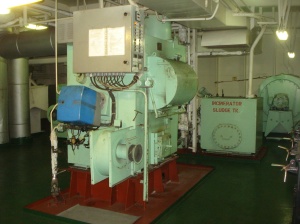 In the previous entry it was established that an incinerator is a requirement by MARPOL aboard any vessel and is an cost-effective way of waste disposal. However before the focus was possible errors that can hinder its operations therefore, it is worth dissecting the entire mechanism.
In the previous entry it was established that an incinerator is a requirement by MARPOL aboard any vessel and is an cost-effective way of waste disposal. However before the focus was possible errors that can hinder its operations therefore, it is worth dissecting the entire mechanism.
Firstly, in theory the type of waste that gets incinerated ranges from galley waste, accommodation waste to sewage sludge; type of waste that gradually builds up during the entire voyage and thus grows in size with regards to mass. Incineration, thus reduces the surface area and mass of the waste as it burns it down to ash; a substance that is easy to dispose and not taking up as much space. Burning up waste such as medical and accommodation also reduces the risk of contracting a disease that users may have been exposed to; especially with the Ebola virus being prominent and more common at sea.
Combustion/burning the aforementioned types of waste however also lead to another issue as the process’ by-product is not necessarily harmless as different types of gases escape the chamber; including those than can contain pathogens and toxins building up in the ash itself and filters. Acid gases, metals and dioxins are some of the by-products of incinerator operation; all hazardous to human health.
Talking about potentially hazardous waste, a sludge burner is placed into the machine to burn and dispose sewage, sludge and waste oil. This process reduces the sewage sludge to ash that is less than 20% of original volume. The ash produced breaks down into 2 types; ash coming from the furnace itself is mixed with slag that is not as hazardous as ash coming from the stack which contains aforementioned dioxins, metals and acid gases. Incinerators on ships are mostly in enclosed space; making it more dangerous for operators as they can inhale the toxic by-product.
The toxic by-product warrants technology or cleaning of air as gases from this category can be persistent and thus remain in the area for extended time; needing air pollution control equipment. Air pollution control equipment either to remove small particles and metals in exhaust gas or further decompose the organic components. Metals can be challenging to remove but regardless has technology placed for this cause; wet scrubbers and dry wet electrostatic precipitators where the former is a diverse group of devices which works via contact of scrubbing solution and target compounds where the scrubbing solution is made specifically to target certain compounds.
The latter works by induction of an electrostatic charge which impedes the overall flow of particles. Wet scrubbers provide direct energy to the flowing medium while electrostatic precipitators provides energy to the particulate matter being collected. Air pollution is also controlled by afterburners which completely burn organics in exhaust gases.
So far, we have seen that incinerators release potentially hazardous by-products which if not properly addressed, can negatively affect the crew. To protect the crew it is necessary to control the release of the by-product with pollution counter-measures which involve electricity, chemicals, heat and design decisions; variables that are relatively expensive. An incinerator is heavily mechanised and capitalised investment; along with the fact that it is a requirement hence necessary, there is the additional cost of design, operation and energy costs as well as maintenance and upgrade operations.
The economical perspective of incinerators relates to the type and the amount of waste to be incinerated as well as calculations on maintenance and upgrade operations; bringing in additional costs of spare parts, maintenance tools and energy sources. In case of shipping and maritime it is important to consider the overall environment; winds, air, sea and local ecology. Feasibility is also an important consideration as incinerator operation in some places may hinder other jobs aboard. Another general rule for incinerator operation and feasibility is based on the overall sludge input rate which ranges between 0.25 and 3 dry tons/hour; where less than 0.25 will be too expensive for the technology and above 3 needs more than one incinerator.

